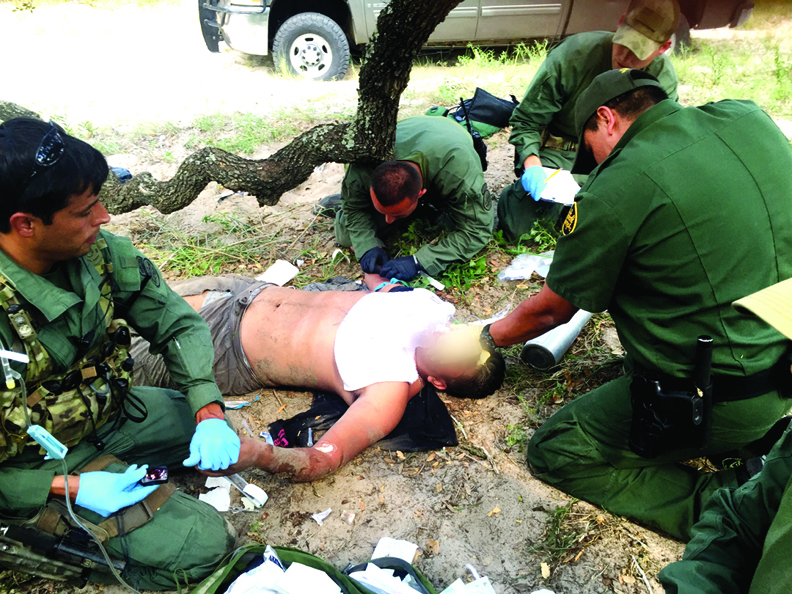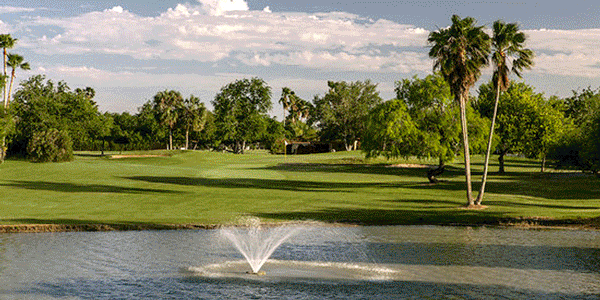Border Patrol Search, Trauma and Rescue
published in the September 2015 issue
The warm season here in the Rio Grande Valley
stretches from May through September with
average daytime temperatures exceeding 90° F.
Add in high relative humidity values and heat
index values can consistently reach over 100
°F during these months. Put this in conjunction
with arid brushland covering hundreds of
square miles and you have a recipe for disaster.
This potential disaster is faced weekly by
hundreds of undocumented aliens making their
way into the United States along the Texas -
Mexico border. Not only by them but by the
men and women of the US Border Patrol whose
duties include patrolling these hot, dry areas
and responding to calls of distress.
In the year 1998 the RGV Sector BORSTAR
(Border Patrol Search, Trauma and Rescue) unit was established to provide assistance to
anyone who was lost or otherwise in distress.
The RGV BORSTAR unit is a well disciplined
and well equipped group of specially
trained agents who face the reality of the Rio
Grande Valley's harsh environment on a daily
basis. Whether they are responding to a call to
search for lost individuals or groups, or they are
assisting in disaster relief efforts, BORSTAR
agents are always prepared and ready to face
the challenge of whatever lies before them.
It takes specialized training to become a part
of the RGV BORSTAR unit. Qualifying agents
must complete a rigorous five week training
course at the Special Operations Group (SOG)
Headquarters in El Paso, Texas.
Elements of this training include:
• Physical Stamina - Building physical endurance
for coping with high stress situations.
• Land Navigation - Utilizing maps and navigating
through rough terrain.
• Swimming - Learning survival swimming
and rescue techniques.
• Swift Water Training - Coping with the dangers
of rescuing in flooded areas.
• Air Operation - Learning Helicopter Rope
Suspension Techniques (HRST).
• Incident Command - Setting up and maintaining
communication during a mission.
• Tactical Medicine - Learning to stabilize a
subject for transport to a medical facility.
• Search and Rescue - Utilizing all aspects of
their training in actual circumstances.

A Day in the Shoes of a BORSTAR OPERATOR
by BORSTAR operator Daniel Reyes
Most undocumented aliens risk their lives for
the opportunity to work and provide a suitable
living for themselves and their families.
What many don't know is the danger they
subject themselves to. Crossing the ranch lands
of Falfurrias, TX, is one of the many obstacles
these UDA (Undocumented Aliens)'s face on
their journey. Hiking anywhere from 15 to 40
miles through sandy, hilly pastures in an attempt
to avoid detection and capture by Border
Patrol Agents. Many of these people are
unprepared and are unable to carry the amount
of water needed for the voyage.
As BORSTAR operators it's our job to locate and treat these
people in distress so that they don't become casualties.
In June of 2014, I was dispatched to a remote
region near Falfurrias, Texas. Local 911
dispatchers provided BORSTAR agents with
a callback number and GPS Coordinates of a
woman in distress. Our first action was to call
the victim. During the interview, she mentioned
that she had not had anything to eat or drink in
over two days and was on the brink of passing
out. As I attempted to gather information, she
interrupted me and said, "My battery is about to
die, please save me." That was the last I heard
from her before the connection was lost.
We immediately began our search. The GPS
coordinates led me to a remote ranch approximately
14 miles from the nearest road. Phase 2
coordinates will normally get you within 100
meters of the caller, but that day only Phase
1 coordinates were obtained, accurate up to 3
miles.
I began driving the perimeter fences looking
for footprints or disturbances within the environment
that would lead me to the victim. Minutes
turned into hours as my team and I searched
for any sign of the female in distress. Finally, I
came across a single running W shoe print with
concentric circles within the heel, and I knew
that we were in the right area.
My partner and I
gathered our large medical bag, collapsible litter
and began tracking through the sandy mots
looking for a possibly unresponsive victim. A
mile into the brush we came across a small female
shirt and in the distance we saw a silhouette
of a person leaning up against a tree.
We ran to her location to find her sluggishly
alert to our presence. "Ayudame" she cried
as we began our assessments looking for the
signs and symptoms associated with heat exhaustion
and dehydration. We gave her cold
water and began treating her while simultaneously
communicating with other agents to assist in a litter carry. After determining that this person was severely dehydrated we began
intravenous therapy with saline solution and began
extraction to a hospital for definitive care.
In this case, our patient, a Honduran mother of
three did not fall victim to the elements. We as
BORSTAR Operators uphold our motto daily
and will stop at nothing to find those that are
lost, treat those that are injured, and save those
that need rescue.
Border Patrol Search, Trauma and Rescue Operators live by a motto
"So Others May Live"
This motto is shared by many Search and rescue
entities to ingrain the character needed to
perform the tasks at hand. You must be competent,
dedicated and selflessly devoted to the
preservation of life to stand up against the elements
and timely physical demands presented
on a daily basis.
We work in hot, isolated environments with
limited resources. Off road doesn't properly describe
the deep soft sand we patrol, pushing our
4x4 vehicles to their absolute limits at times.
When regular patrol work turns into emergent
medical assistance, we quickly change our hats
from Border Patrol Agents to a highly trained
rescue unit capable of responding to almost any
emergency.
The human body is very versatile. It is capable
of compensating to overcome the elements.
When exposed to hot temperatures the
body begins to produce sweat at the surface of
the skin. The circulatory system then begins to
circulate blood to the dermis in an attempt to
cool the core temperature and maintain a level
of homeostasis within the body. In order for
these compensation mechanisms to be of use,
one needs to be hydrated and well-nourished
with an adequate balance of sodium and potassium
electrolytes. If insufficient, the body will
no longer be able to compensate. The body
will start to cramp, begin to overheat and if not
treated in a timely fashion, kidney failure and
death will inevitably follow.








